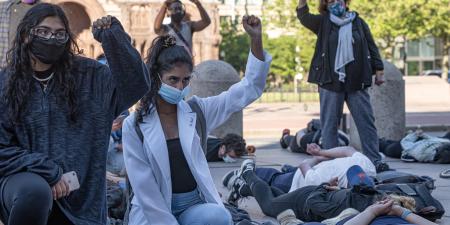Abstract
This commentary responds to a case about a Latino grocery worker who begins experiencing symptoms but is reluctant to be tested for SARS-CoV-2 and be treated for COVID-19 out of fear of losing his livelihood. The case reveals key weaknesses in US health care system capacity to mount evidence-based responses to mitigate, if not contain, spread of a deadly contagion in vulnerable populations and to care equitably for everyone at risk.
Case
Mr S is a 55-year-old Latino man who lives in a 2-bedroom apartment with relatives and supports his family by working in a grocery store. During the COVID-19 pandemic in the United States in 2020, Mr S is an essential worker. He reports symptoms of low-grade fever, chills, cough, shortness of breath, and pleuritic chest pain. When working becomes impossible due to his increasingly severe shortness of breath over 2 weeks, he visits a clinic and is diagnosed with COVID-19. He becomes lethargic as his symptoms become more acute and is transferred by ambulance to a local emergency department, his oxygen saturation now in the low 90s.
Mr S’s past medical history includes type 2 diabetes mellitus, obesity (body mass index of 34), hyperlipidemia, hypertension, hypothyroidism, gastroesophageal reflux disease, obstructive sleep apnea, and vitamin D deficiency. A frontal chest radiograph demonstrates bilateral multifocal airspace opacities consistent with multifocal COVID-19 pneumonia. Intensive care unit (ICU) admission with intubation and close monitoring is recommended. Mr S expresses worry, however, about his inadequate insurance coverage, inability to pay for an ICU stay, and not being able to work. Mr S asks to be discharged against medical advice, but eventually agrees to ICU admission for management of COVID-related acute respiratory distress syndrome.
Mr S is intubated for 13 days, during which time his condition is complicated by COVID-related cardiomyopathy and superimposed bacterial pneumonia. He is transferred from the ICU to a general medical floor on day 14. On day 26, Mr S is discharged to a rehabilitation facility.
When Mr S was asked why he did not get evaluated and quarantine as soon as his symptoms started, he responded that the grocery store where he worked remained open during the COVID-19 pandemic because grocery stores were considered “essential” by the state and that he had no option for remote work. Mr S’s employer did not offer flexible medical leave, and Mr S was concerned that his insurance would not adequately cover the medical costs for an emergency room visit and potential hospitalization at an out-of-network hospital. These concerns were exacerbated by his lack of financial reserve to pay monthly bills and support his family. Mr S concealed his symptoms to keep working and to avoid medical debt.
Commentary
Societal privilege, or lack thereof, has affected the ability of Latinx individuals to protect themselves from COVID-19 transmission and financially support their families during a global pandemic. Societal privilege results when particular groups benefit and prosper because of the advantages, entitlements, and dominance conferred on them by society.1 Domains of privilege include gender, race, sexual orientation, socioeconomic status, and religious affiliation. Latinx individuals’ lack of societal privilege has increased the vulnerability of the Latinx community and has resulted in extreme health inequities during the COVID-19 pandemic. As discussed here, layers of vulnerability in the Latinx community include overrepresentation in low-wage work, education gaps and language barriers, financial constraints, social factors and living conditions, and disparate coexisting medical conditions. Current weaknesses in the US health care system (eg, lack of trust, limited health outcomes research in underrepresented populations, and outdated policies that drive inequity) exacerbate these vulnerabilities.
Layers of Vulnerability in Latinx Communities
Types of employment. In response to the COVID-19 pandemic, many states temporarily suspended business to slow viral transmission. While many people were able to work remotely, many like Mr S were deemed essential by states and required to continue working to provide services outside their homes, which helped social functioning but inequitably increased their exposure to SARS-CoV-2. Although social distancing and self-isolation recommendations were supported by the Centers for Disease Control and Prevention (CDC),2 paid sick leave and working remotely were not options for many workers.3
Vulnerable populations, including Latinx communities, are overrepresented in this low-wage public-facing workforce (eg, transportation, food, and agriculture) and are more likely to be exposed to the virus.4 Historically, non-White populations have been driven into low-wage employment with little flexibility in work hours and little or no paid time off. Specifically, prior to the pandemic, only 16.2% of Latinx workers held jobs that would allow for remote work compared to 31.4% of non-Latinx workers.5
Financial strains of the pandemic have forced many to choose between continuing to work while infected or staying home without income.
Education and language barriers. Latinx individuals are half as likely to hold a college degree as non-Latinx White adults.6 This widening educational divide contributes to the aforementioned overrepresentation of Latinx individuals in low-wage jobs with little flexibility. The educational gap is further exacerbated by the scarcity of policies and programs to support the advancement and financial stability of low-wage workers, as demonstrated by the weak enforcement of antidiscrimination laws and the dearth of organizational initiatives to improve worker skills and promote good jobs through economic and workforce development.7 Furthermore, 28.4% of Latinx individuals are not fluent in English, and 71% of Latinx individuals speak a language other than English at home.8 This lack of full fluency in English can decrease access to health care, impair delivery of high-quality care, increase length of inpatient stays, and result in worse health outcomes.9
Financial constraints. Mr S’s financial circumstances mirror those of the majority of Latinx adults in the United States. Many Latinx families are under marked financial pressures, with the poverty rate for Latinx individuals being nearly double that for non-Latinx Whites (19.4% vs 9.6%, respectively).5 Approximately 70% of Latinx adults in the United States do not have emergency funds to cover 3 months of expenses.10 Added financial strains of the pandemic have forced many to choose between continuing to work while infected or staying home without income.
Mr S’s avoidance of medical care due to his lack of insurance and fear of mounting medical cost is not uncommon. Many Latinx individuals cannot afford health insurance, and those who can are often underinsured and forced to pay out-of-pocket expenses that are unaffordable and continue to increase over time.11 Latinx individuals have the lowest rates of health insurance of all racial or ethnic groups in the United States except American Indians/Alaska Natives.11 In 2018, 26.7% of Latinx adults ages 18 to 64 were uninsured, compared to only 9.0% of non-Latinx Whites.12 In 2019, approximately 21% of Latinx adults ages 18 and older in the United States went without care due to costs.13
Social factors and living conditions. Like Mr S, many Latinx families live in multigenerational homes that make it difficult to isolate and social distance in the event of a positive COVID-19 test.14 These more crowded living conditions for the Latinx community might also increase vulnerability to the virus, making even a decision to stay home risky. Furthermore, Latinx individuals are overrepresented in congregate settings, such as prisons,15 which can further increase risk exposure and limit one’s ability to keep distant, per CDC recommendations.16
Coexisting medical conditions. Like Mr S, many Latinx individuals may be more susceptible to severe cases of COVID-19 because of coexisting medical conditions. Specifically, Latinx individuals diagnosed with COVID-19 have higher rates of hospitalization and ICU admission than White individuals, regardless of whether they had coexisting medical conditions such as hypertension, cardiovascular disease, kidney disease, or diabetes.17 The layers of vulnerability in the Latinx community, including presence of coexisting medical conditions, result in higher COVID-19 morbidity and mortality in the Latinx community. Specifically, in November 2021, the rates of COVID-19 mortality, hospitalizations, and cases in Latinx individuals were 2.1 times, 2.5 times, and 1.6 times higher, respectively, than those of non-Latinx Whites.18
Reorganizing US Health Care
While the US health care system cannot undo what has been done, the system must begin to address the complex combination of economic, physical, and social forces undermining the health of Latinx communities in the midst of this public health crisis. The case of Mr S serves to highlight the disproportionate impact that these combined factors can have on one’s decision to pursue, avoid, or delay health care.
This inequity prompts us to wonder, How should the US health care system be restructured to meet the needs of the Latinx community during and after the COVID-19 pandemic? To begin, the US health care system must urgently acknowledge its current inability to provide high-quality care for vulnerable populations. It must recognize that the health care crises faced by individuals such as Mr S are not isolated incidents. Rather, these all-too-common events in combination represent a pervasive threat to the overall health of the nation. A pandemic cannot be controlled if certain portions of the population are made, and then left, vulnerable to illness.
Practical initial steps for the US health care system to take to achieve more equitable care for vulnerable populations include building trust with vulnerable populations, improving data collection on health outcomes in underrepresented populations, increasing research funding for studies dedicated to improving equitable care, and driving policy change to make health care affordable and accessible for everyone.5,19 Such policy changes might include offering public options for health insurance, expanding Medicaid coverage in all states, lowering consumer costs for medical care, providing nonemergency transportation for medical care, and having community health workers or navigators available.20
One challenge in reorganizing US health care lies in implementing the monumental changes necessary to make lasting impact. Lasting impact can only be made when both the US health care system and society dismantle the existing system of social privilege, combat centuries of structural racism, and overcome cultural and socioeconomic inequities in access to health care.5
Conclusion
COVID-19 has laid bare health inequity in Latinx communities that is closely linked with lack of social privilege, low-paid public-facing employment, substandard housing, lower level of education, language barriers, and financial constraints. To address health inequity, US health care must acknowledge its weaknesses and welcome the challenge of redesigning health care delivery from the top down through the lens of health equity. Changing existing systems of social privilege, structural racism, and socioeconomic inequity are critical to health care reform success.
References
- Black LL, Stone D. Expanding the definition of privilege: the concept of social privilege. J Multicult Couns Devel. 2005;33(4):243-255.
-
How to protect yourself and others. Centers for Disease Control and Prevention. Accessed November 5, 2021. https://www.cdc.gov/coronavirus/2019-ncov/prevent-getting-sick/prevention.html
-
Schneider D, Harknett K. Essential and vulnerable: service sector workers and paid sick leave. Shift Project; 2020. Accessed February 17, 2022. https://shift.hks.harvard.edu/files/2020/04/Essential_and_Vulnerable_Service_Sector_Workers_and_Paid_Sick_Leave.pdf
- Roberts JD, Dickinson KL, Koebele E, et al. Clinicians, cooks, and cashiers: examining health equity and the COVID-19 risks to essential workers. Toxicol Ind Health. 2020;36(9):689-702.
- Macias Gil R, Marcelin JR, Zuniga-Blanco B, Marquez C, Mathew T, Piggott DA. COVID-19 pandemic: disparate health impact on the Hispanic/Latinx population in the United States. J Infect Dis. 2020;222(10):1592-1595.
-
Ed Trust research shows need for policymakers to address racial gaps in degree attainment. News release. Education Trust; June 14, 2018. Accessed April 8, 2021. https://edtrust.org/press-release/ed-trust-research-shows-need-policymakers-address-racial-gaps-degree-attainment/
-
Hanks A, Solomon D, Weller CE. Systematic inequality: how America’s structural racism helped create the Black-White wealth gap. Center for American Progress. February 21, 2018. Accessed November 5, 2021. https://www.americanprogress.org/article/systematic-inequality/
-
Profile: Hispanic/Latino Americans. Office of Minority Health, US Department of Health and Human Services. Accessed September 15, 2021. https://minorityhealth.hhs.gov/omh/browse.aspx?lvl=3&lvlid=64
-
Quick Safety 13: overcoming the challenges of providing care to limited English proficient patients. Joint Commission. May 28, 2015. Accessed September 15, 2020. https://www.jointcommission.org/resources/news-and-multimedia/newsletters/newsletters/quick-safety/quick-safety--issue-13-overcoming-the-challenges-of-providing-care-to-lep-patients/
-
Lopez MH, Rainie L, Budiman A. Financial and health impacts of COVID-19 vary widely by race and ethnicity. Fact Tank. May 5, 2020. Accessed September 15, 2021. https://www.pewresearch.org/fact-tank/2020/05/05/financial-and-health-impacts-of-covid-19-vary-widely-by-race-and-ethnicity/
-
Artiga S, Hill L, Orgera K, Damico A. Health coverage by race and ethnicity, 2010-2019. Kaiser Family Foundation. July 16, 2021. Accessed November 5, 2021. https://www.kff.org/racial-equity-and-health-policy/issue-brief/health-coverage-by-race-and-ethnicity/
-
Agency for Healthcare Research and Quality. 2018 National Healthcare Quality and Disparities Report. US Department of Health and Human Services; 2019. AHRQ publication 19-0070-EF. Accessed September 15, 2021. https://www.ahrq.gov/sites/default/files/wysiwyg/research/findings/nhqrdr/2018qdr.pdf
-
Adults who went without care because of cost. Commonwealth Fund Health System Data Center. Accessed February 19, 2021. https://datacenter.commonwealthfund.org/topics/adults-who-went-without-care-because-cost
-
The challenges of shelter-in-place for Black and Latinx Communities. State of Public Health. March 27, 2020. Accessed September 15, 2021. https://stateofpublichealth.com/environmental-health/the-challenges-of-shelter-in-place-for-black-and-latinx-communities/
-
Sakala L. Breaking down mass incarceration in the 2010 census: state-by-state incarceration rates by race/ethnicity. Prison Policy Initiative. May 28, 2014. Accessed November 5, 2021. https://www.prisonpolicy.org/reports/rates.html
-
Rabin RC. In Massachusetts, inmates will be among first to get vaccines. New York Times. December 18, 2020. Accessed February 17, 2020. https://www.nytimes.com/2020/12/18/health/coronavirus-vaccine-prisons-massachusetts.html
-
Izzy S, Tahir Z, Cote DJ, et al. Characteristics and outcomes of Latinx patients with COVID-19 in comparison with other ethnic and racial groups. Open Forum Infect Dis. 2020;7(10):ofaa401.
-
Risk for COVID-19 infection, hospitalization, and death by race/ethnicity. Centers for Disease Control and Prevention. Accessed September 15, 2021. https://www.cdc.gov/coronavirus/2019-ncov/covid-data/investigations-discovery/hospitalization-death-by-race-ethnicity.html
- Metzl JM, Maybank A, De Maio F. Responding to the COVID-19 pandemic: the need for a structurally competent health care system. JAMA. 2020;324(3):231-232.
-
Rapfogel N, Calsyn M. Public options will improve health equity across the country. Center for American Progress. May 5, 2021. Accessed November 5, 2021. https://www.americanprogress.org/issues/healthcare/reports/2021/05/05/499134/public-options-will-improve-health-equity-across-country/



